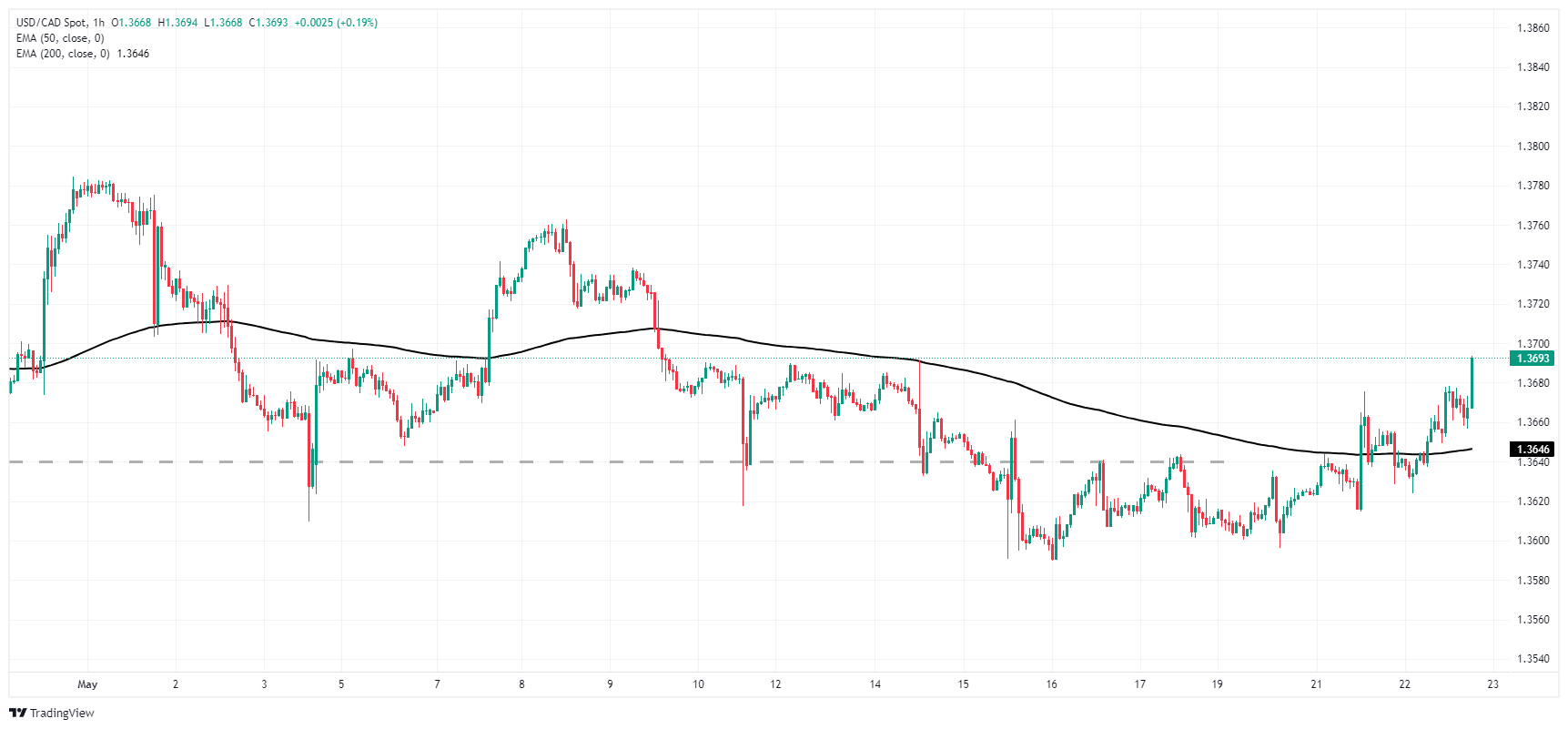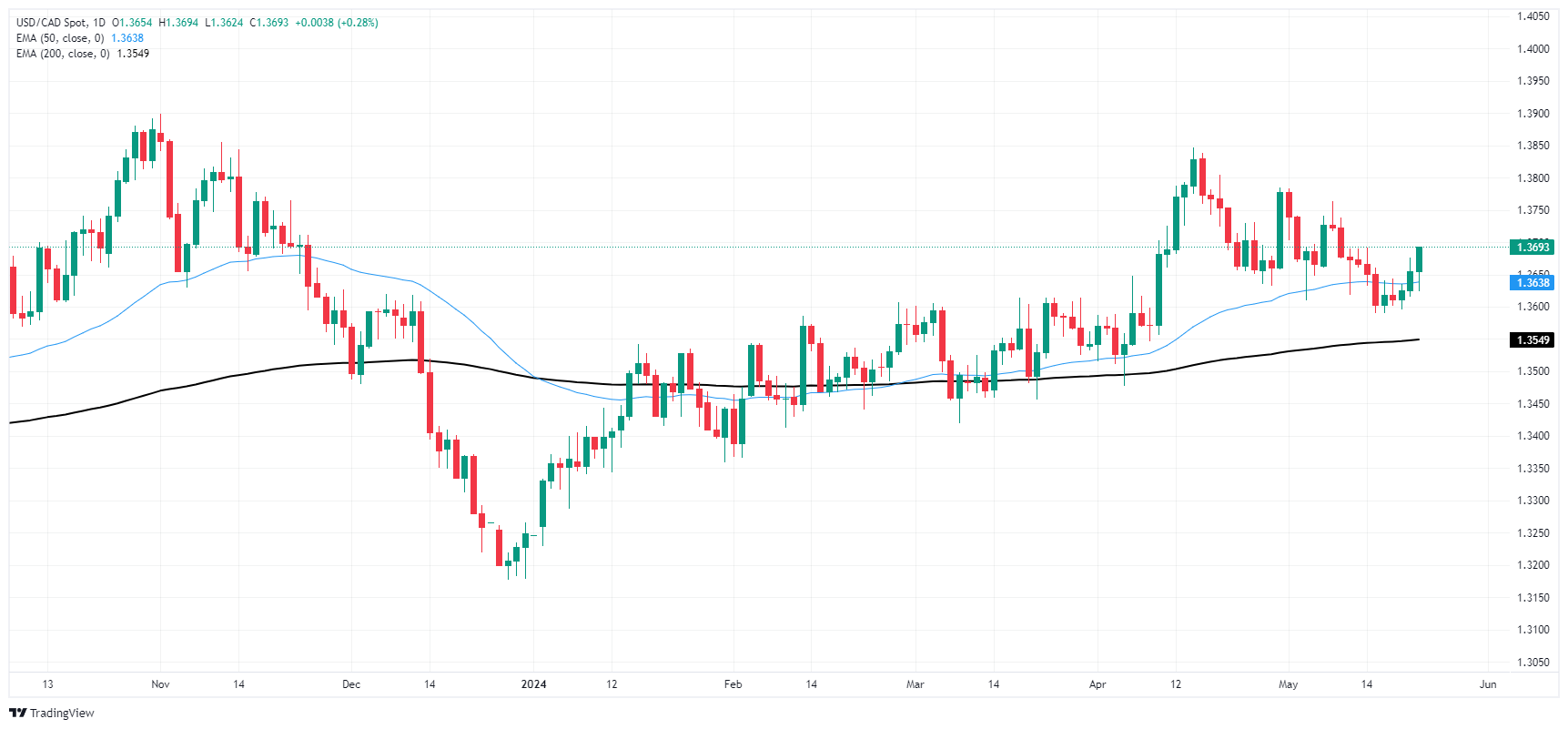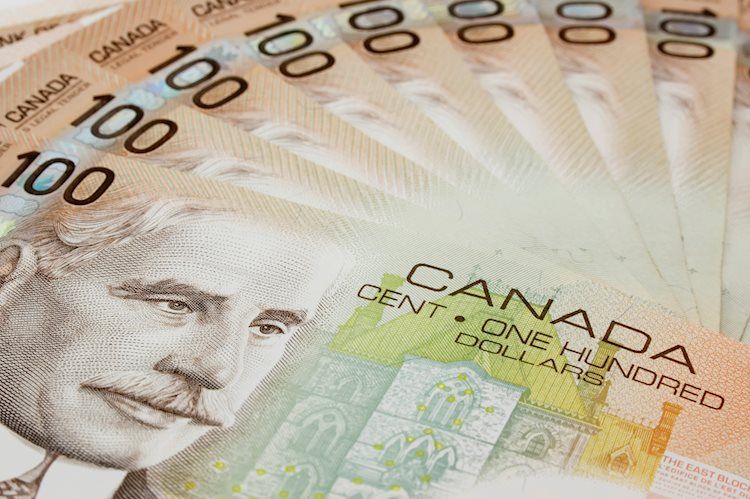- Canadian Dollar is broadly softer as CAD loses defensive posture.
- Canada brings only low-tier data until Friday’s Retail Sales.
- US Home Sales disappoint, Fitch warns of sticky inflation.
The Canadian Dollar (CAD) slipped on Wednesday as broader market sentiment weakened. This dragged the CAD lower and sent bids into the US Dollar (USD). The Canadian Dollar fell to its lowest price against the Greenback in a week, setting up the USD for its third consecutive gain against the CAD.
Canada delivers strictly mid-tier data for the remainder of the trading week, and CAD investors will have to wait until Friday for March’s Canadian Retail Sales. US data will be the key for the rest of the week.
Daily digest market movers: Canadian Dollar eases back, Greenback finds room up top
- The Federal Reserve’s (Fed) latest Meeting Minutes showed that the FOMC remains skeptical about inflation progress after Q1’s disappointing price growth figures.
- Risk-off bids into Greenback bidding after internal discussions at the Fed revealed concerns over the “restrictiveness” of policy, rather than discussing the timing of rate cuts as investors have been hoping.
- The FOMC didn’t rule out rate cuts in 2024, but reiterated the need for further signs of disinflation progress.
- US Existing Home Sales fell for a second straight month to 4.14 million, missing the forecast 4.21 million and declining from the previous 4.22 million (revised up slightly from 4.19 million).
- Fitch Ratings warned on Wednesday that services inflation across the globe is likely to remain sticky. The ratings agency cautioned that stubborn prices will likely slow the pace of rate cuts.
- US Purchasing Managers Index (PMI) data is due on Thursday, investors are hoping for a flat print.
- Canadian Retail Sales, US Durable Goods Orders to wrap up the trading week on Friday.
- Read more: Fed Minutes leave the door open to a probable rate cut in September
Canadian Dollar PRICE Today
The table below shows the percentage change of Canadian Dollar (CAD) against listed major currencies today. Canadian Dollar was the weakest against the US Dollar.
| USD | EUR | GBP | JPY | CAD | AUD | NZD | CHF | |
|---|---|---|---|---|---|---|---|---|
| USD | 0.33% | -0.03% | 0.33% | 0.31% | 0.85% | 0.10% | 0.48% | |
| EUR | -0.33% | -0.35% | 0.00% | -0.03% | 0.53% | -0.23% | 0.15% | |
| GBP | 0.03% | 0.35% | 0.36% | 0.28% | 0.90% | 0.13% | 0.52% | |
| JPY | -0.33% | 0.00% | -0.36% | -0.04% | 0.51% | -0.16% | 0.16% | |
| CAD | -0.31% | 0.03% | -0.28% | 0.04% | 0.55% | -0.15% | 0.18% | |
| AUD | -0.85% | -0.53% | -0.90% | -0.51% | -0.55% | -0.73% | -0.35% | |
| NZD | -0.10% | 0.23% | -0.13% | 0.16% | 0.15% | 0.73% | 0.36% | |
| CHF | -0.48% | -0.15% | -0.52% | -0.16% | -0.18% | 0.35% | -0.36% |
The heat map shows percentage changes of major currencies against each other. The base currency is picked from the left column, while the quote currency is picked from the top row. For example, if you pick the Canadian Dollar from the left column and move along the horizontal line to the US Dollar, the percentage change displayed in the box will represent CAD (base)/USD (quote).
Technical analysis: Canadian Dollar sheds another fifth of a percent against Greenback
The Canadian Dollar (CAD) was broadly lower on Wednesday, falling four-tenths of one percent against both the New Zealand Dollar (NZD) and the Pound Sterling (GBP). However, the CAD was up one-quarter of one percent against the Australian Dollar (AUD) as the Aussie fell to the bottom of the board in the midweek market session.
USD/CAD is on pace for a third straight daily gain as the pair firms up on a technical recovery from the 50-day Exponential Moving Average (EMA) at 1.3637. The 1.3640 level remains a key technical barrier, and buyers will be looking to launch another leg higher if bids fall back to the middle zone.
Daily candles continue to hold on the north side of the 200-day EMA at 1.2550, keeping the Greenback’s bullish stance against the Canadian Dollar.
USD/CAD hourly chart
USD/CAD daily chart
Fed FAQs
Monetary policy in the US is shaped by the Federal Reserve (Fed). The Fed has two mandates: to achieve price stability and foster full employment. Its primary tool to achieve these goals is by adjusting interest rates. When prices are rising too quickly and inflation is above the Fed’s 2% target, it raises interest rates, increasing borrowing costs throughout the economy. This results in a stronger US Dollar (USD) as it makes the US a more attractive place for international investors to park their money. When inflation falls below 2% or the Unemployment Rate is too high, the Fed may lower interest rates to encourage borrowing, which weighs on the Greenback.
The Federal Reserve (Fed) holds eight policy meetings a year, where the Federal Open Market Committee (FOMC) assesses economic conditions and makes monetary policy decisions. The FOMC is attended by twelve Fed officials – the seven members of the Board of Governors, the president of the Federal Reserve Bank of New York, and four of the remaining eleven regional Reserve Bank presidents, who serve one-year terms on a rotating basis.
In extreme situations, the Federal Reserve may resort to a policy named Quantitative Easing (QE). QE is the process by which the Fed substantially increases the flow of credit in a stuck financial system. It is a non-standard policy measure used during crises or when inflation is extremely low. It was the Fed’s weapon of choice during the Great Financial Crisis in 2008. It involves the Fed printing more Dollars and using them to buy high grade bonds from financial institutions. QE usually weakens the US Dollar.
Quantitative tightening (QT) is the reverse process of QE, whereby the Federal Reserve stops buying bonds from financial institutions and does not reinvest the principal from the bonds it holds maturing, to purchase new bonds. It is usually positive for the value of the US Dollar.
